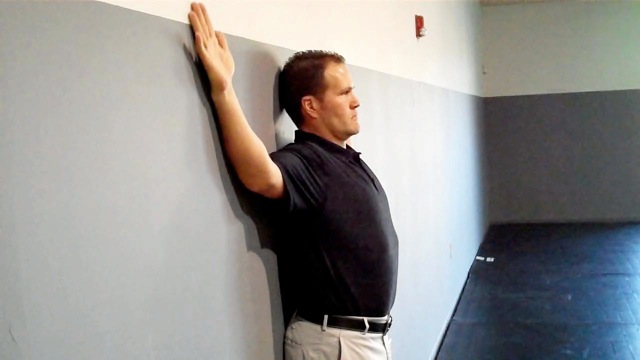
This is an exercise that forces the client to focus on maintaining proper scapular alignment through consistent kinesthetic feedback. Initially, it may be easier for clients to do it supine on the floor (gravity eliminated position), but for the column I am describing the exercise standing against a wall.
Execution:
|
|
|
|
|
|
Application:
The exercise is designed to promote scapular stability. When done properly, the client will demonstrate proper upward rotation (avoid tipping and winging of the scapula) on the ascent, and then emphasize recruitment of the rhomboids and lower trap to achieve proper downward rotation on the descent.
It can be a very fatiguing activity and somewhat frustrating for clients when starting out. Be sure to cue them accordingly, and let them know it may not be easy to keep full contact. It may also be necessary to utilize soft tissue mobilization for the pecs/lats as well as stretching beforehand to promote a more normal movement pattern.
You may eventually be able to use some light hand weights, however, keep in mind that the most important objective is generating the desired force couple activation and promoting a normal scapulo-humeral rhythm through the proper muscle recruitment patterns.
Additional Notes:
Do not encourage clients to push through any pain or uncomfortable range of motion. Additionally, if they display significant difficulty with the standing version, regress to the supine position. Finally, if you observe marked asymmetry, consider performing an alternate arm technique to allow them to better focus on one side at a time.
Brian Schiff, PT, CSCS, is a licensed physical therapist, respected author and fitness professional. Currently, he serves as the supervisor at the Athletic Performance Center in Raleigh, NC. Brian presents nationally at several professional conferences and seminars on injury prevention, rehab and sport-specific training. For more cutting edge training information, subscribe to his monthly Training & Sports Medicine Update at www.BrianSchiff.com.
 Begin standing against a wall (facing away from it). Position the arms relaxed in a normal carrying position with the back of the hands against the wall. Next, retract and slowly slide the arms up the wall. The elbows can remain flexed slightly less than 90 degrees throughout.
Begin standing against a wall (facing away from it). Position the arms relaxed in a normal carrying position with the back of the hands against the wall. Next, retract and slowly slide the arms up the wall. The elbows can remain flexed slightly less than 90 degrees throughout. Once you pass 90 degrees of shoulder flexion it may become harder to maintain contact with the wall, especially if there is any remarkable tightness in the pecs or lats. Continue to fully elevate the arms overhead working hard to maintain proper alignment and contact with the top of the scapula and the wall.
Once you pass 90 degrees of shoulder flexion it may become harder to maintain contact with the wall, especially if there is any remarkable tightness in the pecs or lats. Continue to fully elevate the arms overhead working hard to maintain proper alignment and contact with the top of the scapula and the wall. Pause at the top and then slowly lower back down now focusing on squeezing the shoulder blades down and back toward one another (think pulling the elbow into the back pocket). Perform 5-10 slow and deliberate repetitions and repeat for 2-3 sets. Editor's Note: Brian has pec/lat tightness which pulls the shoulders forward in this demonstration.
Pause at the top and then slowly lower back down now focusing on squeezing the shoulder blades down and back toward one another (think pulling the elbow into the back pocket). Perform 5-10 slow and deliberate repetitions and repeat for 2-3 sets. Editor's Note: Brian has pec/lat tightness which pulls the shoulders forward in this demonstration.















